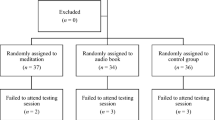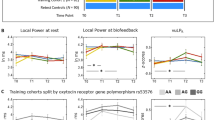Abstract
The effectiveness of cardiac education and visual biofeedback of heart rate as a training procedure to teach people to control their heart rate to a psychological stressor was investigated with 36 students, half of whom acted as control subjects. Training took 5 weeks and consisted of 30-min per week of awareness training, plus exercises to increase and decrease heart rate under rest and stressful conditions, with monetary rewards for success. Effects were tested by pre-post test comparisons between the control and the experimental groups, and results indicated that the group which received training significantly lowered its heart rate reactivity even though not specifically instructed to do so. However, when instructed to control heart rate reactivity for a monetary reward, the control group also succeeded at this task, raising several issues regarding the efficacy of reactivity training.
Similar content being viewed by others
References
Bradley, B., W., and McCanne, T. R. (1981). Autonomic responses to stress: The effects of progressive relaxation, the relaxation response, and expectancy of relief.Biofeedback Self-Regul. 6: 235–251.
Goldstein, D. S., Ross, R. S., and Brady, J. V. (1984).Biofeedback heart rate training during exercise.Biofeedback Self-Regul. 2: 107–126.
Jorgensen, R. S., Nash, J. K., Lasser, N. L., Hymowitz, N., and Langer, A. W. (1988). Heart rate acceleration and its relationship to total serum cholesterol, triglycerides, and blood pressure reactivity in men with mild hypertension.Psychophysiology 25: 39–44.
Leon, G. R., Finn, S. E., Murray, D., and Bailey, J. M. (1988). Inability to predict cardiovascular disease from hostility scores or MMPI items related to Type A behavior.J. Consul. Clin. Psychol. 56: 597–600.
Lo, C. R., and Johnston, D. W. (1984). Cardiovascular feedback during dynamic exercise.Psychophysiology 21: 199–206.
Manuck, S. B., and Proietti, J. M. (1982). Behaviorally-induced heart-rate reactivity and atherosclerosis in cynomulgus monkeys.Psychosom. Med. 45: 95–108.
Matthews, K. A., Weiss, S. M., Detre, T., Dembroski, T. M., Falkner, B., Manuck, S. B., and Williams, R. B. (1986).Handbook of Stress, Reactivity and Cardiovascular Disease, Wiley, New York.
McCanne, T. R. (1983). Changes in autonomic responding to stress after practice at controlling heart rate.Biofeedback Self-Regul. 8: 9–24.
McKinney, M. E., and Gatchel, R. J. (1982). The comparative effectiveness of heart rate biofeedback, speech skills training, and a combination of both intreating public speaking anxiety.Biofeedback Self-Regul. 7: 71–87.
Moses, J., Clemens, W. J., and Brener, J. (1986). Bidirectional voluntary heart rate control during static muscular exercise: Metabolic and respiratory correlates.Psychophysiology 23: 510–520.
Perski, A., and Engel, B. T. (1980). The role of behavioral conditioning in the cardiovascular adjustment to exercise.Biofeedback Self-Regul. 5: 91–104.
Ragland, D. R., and Brand, R. J. (1988). Type A behavior and mortality from coronary heart disease.N. Engl. J. Med. 318: 65–69.
Reeves, J. L., and Shapiro, D. (1982). Heart rate biofeedback and cold pressor pain.Psychophysiology 19: 393–403.
Reeves, J. L., and Shapiro, D. (1983). Heart-rate reactivity to cold pressor stress following biofeedback training.Biofeedback Self-Regul. 8: 87–99.
Sharpley, C. F., Parsons, G. M., and Tillinh, H. (1989). Children's heart rate reactivity responses to three school tasks.Psychol. Schools (in press).
Victor, R., Mainardi, J. A., and Shapiro, D. (1978). Effect of biofeedback and voluntary control procedures on heart rate and perception of pain during the cold pressor test.Psychosom. Med. 40: 216–225.
Wilcox, I., Fletcher, P. J., and Bailey, B. P. (1988). Colour-coded imaging of cardiac blood flow.Med. J. Austral. 148: 288–295.
Author information
Authors and Affiliations
Additional information
This research was supported by National Heart Foundation of Australia Grant E 11.
Rights and permissions
About this article
Cite this article
Sharpley, C.F. Biofeedback training versus simple instructions to reduce heart rate reactivity to a psychological stressor. J Behav Med 12, 435–447 (1989). https://doi.org/10.1007/BF00844877
Accepted:
Issue Date:
DOI: https://doi.org/10.1007/BF00844877




